St. Louis, Missouri, USA
October 15, 2024
Our Plant Growth Facility (PGF) is always buzzing with innovative and essential research, and this year has been no exception. In this blog, you’ll find the details on three of the exciting plant science projects supported by PGF that have been underway this spring and summer.
Predicting Traits from Seed to Vine in Grapes
Grapevines were the focus of one of the standout projects in our greenhouses this year. Grapes are an important agricultural crop, valued not just for eating but also for their role in winemaking.
This study was led by Danielle Hopkins, a graduate student in the Miller Lab. The grapevines were primarily grown to test the ability of an approach known as phenomic prediction. Phenomic prediction is the idea that observations made when plants are young (seeds and seedlings) can be used to predict features those plants will express as adults.
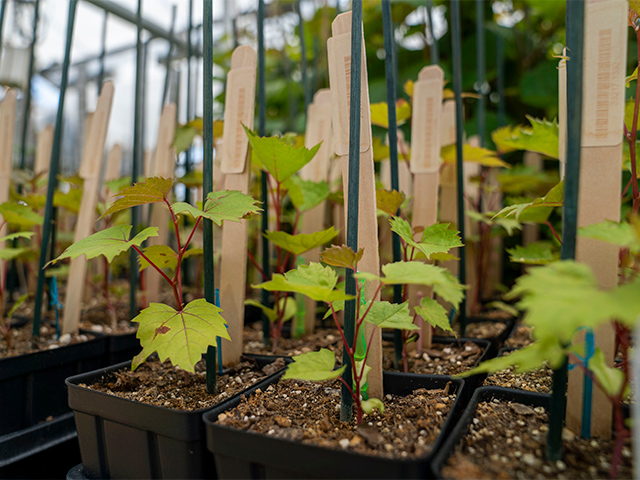
Grapevines grow in the Danforth Center Plant Growth Facility.
The team collected data from seeds and seedlings within six different populations of grapevines and attempted to use those data to develop predictive models for developmental and physiological traits in the plants. They hope to be able to use these models to predict traits across populations, which would be similar to genomic prediction practices in plant breeding programs.
“Phenomic prediction is a relatively new technique that has not been explored in many perennial crops, especially woody perennials like grapevines,” Hopkins explains. “Testing and improving our ability to use phenomic prediction in perennial plant breeding could greatly reduce the cost, time, and space constraints in current standard breeding practices. This experiment serves as a great proof of concept that will help lay the groundwork for employing phenomic prediction in grapevines.”
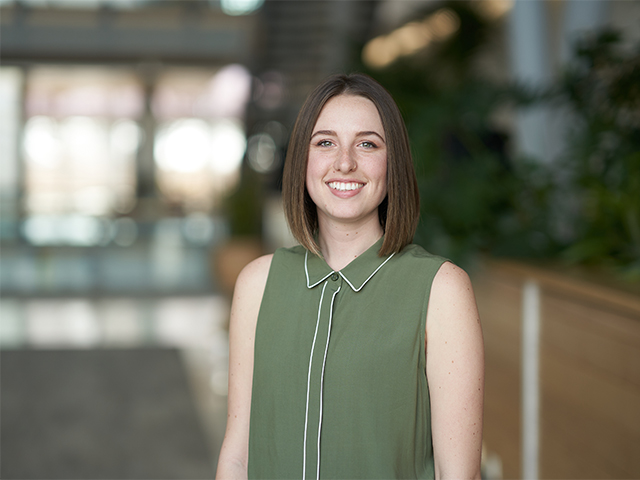
Danielle Hopkins, a graduate student in the Miller Lab, led a study this year focused on phenomic prediction in grapevines.
This experiment was inspired in part by another project in the Miller Lab that took place at the Field Research Site this summer. That project, led by Senior Research Scientist Matthew Rubin, PhD, focused on phenomic prediction in perennial plants. You can read more about it here.
Cultivating Urban Resilience in Collard Greens
Right next door to the grapevine experiment was a study on another familiar food: collard greens. Urban farmers deal with a range of challenges to producing food in cities. Antonio Brazelton, PhD, in the Topp Lab is leading a study on collard greens to help address some of those challenges.
Brazelton is studying 20 varieties of collards as part of a project to better understand root architectural diversity in natural populations and how those traits can be used for breeding in urban and low input agricultural systems. The goal of this experiment is to better understand how collard root traits are inherited from one generation to the next. The team is especially interested in identifying markers for the gene's underlying root traits related to drought tolerance.
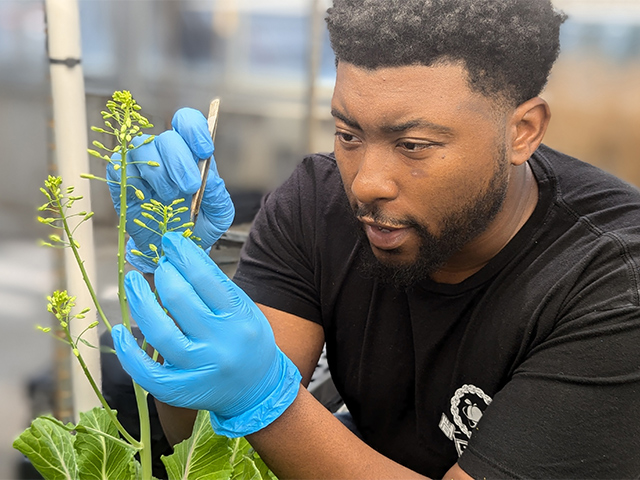
Senior Coordinator of Research Partnerships Antonio Brazelton led research to better understand how to develop collards that are more drought-resistant and better adapted for urban growing environments.
Once the plants reached the 10-leaf stage, at which time they are usually harvested (and eaten), they were moved to a cold chamber to replicate winter conditions. This process, called vernalization, is necessary to induce flowering and seed production in some plant species. After several weeks, they were reintroduced to the greenhouse to imitate springtime. Once they began flowering, Brazelton cross-pollinated the most interesting parents by hand and collected the resulting F1 (first generation) seeds.
Next, Brazelton worked with students in the Jackie Joyner-Kersee Food, Agriculture, and Nutrition Innovation Center (JJK FAN) summer internship program to collect and store leaf samples from the collards that were grown in PGF. These leaf samples will be sequenced for genetic differences to see how they relate to the traits that were previously observed in the collard seedlings.
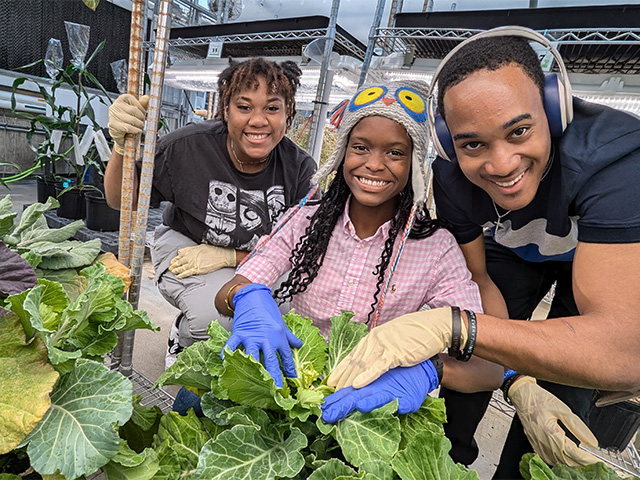
Students from the Jackie Joyner-Kersee Food, Agriculture, and Nutrition Innovation Center (JJK FAN) were a key part of the collards study. Pictured here from left to right are students Zhakeya Hawkins, Tarell Flowers, and Kareemah Watson.
His work with these same 20 collard varieties and their offspring will continue this month when they are planted at the JJK FAN’s new passive solar greenhouse. There, the goal will be to collect root trait data on varieties that are more resilient to drought stress in urban environments.
"In addition to the drought experiment, we aim to collaborate with local farmers, educators, and community members by hosting a taste test and variety trial,” Brazelton says. “From the onset, I was interested in ways to incorporate participatory science, phenomics, and food justice into my PhD experience. When I heard about the Danforth Center’s partnership with the Jackie Joyner-Kersee Food, Agriculture and Nutrition Innovation Center (JJK FAN), I thought it would be a great location for my next set of experiments.”
Brazelton hopes his experiment will inspire other scientists to propose experiments at JJK FAN, where the community can learn more about how projects like these can help scientists build a brighter future—one where our crops are well-suited to survive stressful conditions in our changing climate and where urban farmers confidently plant and harvest the plants that feed their communities.
“Plant science is a powerful tool for creating equitable food systems,” Brazelton says. “Engaging farmers, students, and community members as collaborators in my work has been essential in understanding the unique challenges of growing food in the city.”
Exploring Pennycress Roots in the Mesocosm
Another noteworthy project this year has been a large format mesocosm system in PGF. Mesocosms, an idea spearheaded by Chris Topp, PhD, are customized plant growth boxes equipped with sensors and optimized for observation and data collection as plants grow.
This particular project was led by Marcus Griffiths, PhD. The goal was to bridge the gap between plant experiments that are grown in the field with plant experiments that are grown in pots or other containers. In this large format mesocosm setup, plants are grown to maturity and have free growing space for roots without the restraint that is typical of trials that use containers.
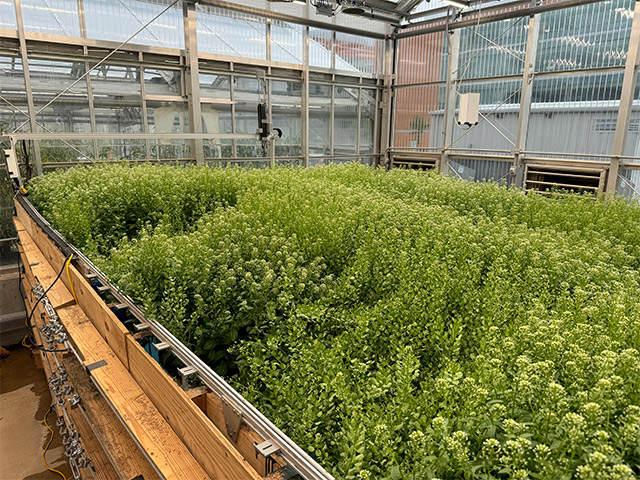
Pennycress blooms in the large format mesocosm housed by the Plant Growth Facility.
The system was used to phenotype pennycress accessions, including the underground world of their roots, as part of the Department of Energy-funded project “IPREP: Interrogating pennycress natural and induced variation to improve abiotic stress tolerance and oilseed bioenergy crop resilience.”
Some plants were sown with larger plant spacing to allow for individual imaging, and others were sown in rows as is typical of growing conditions in the field.
“With the large format mesocosm, we are aiming to answer how pennycress root traits affect performance and ecosystem services such as nutrient capture,” Griffiths explains.
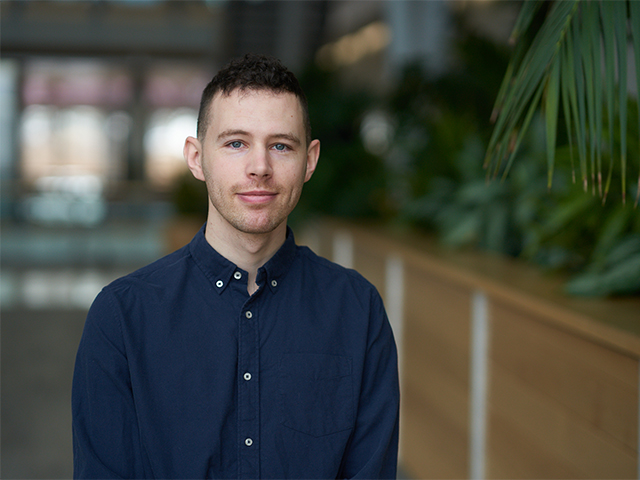
Research Scientist Marcus Griffiths led a study on the roots of pennycress, a promising cover crop.
This project integrates with the wider cover crop initiative in the lab. Pennycress is a promising cover crop and intermediate oil seed crop. Cover crops in general can offer a variety of benefits, including reducing soil erosion, reducing fertilizer runoff, reducing flooding, and storing carbon underground.
“This would not have been possible without the PGF team,” Griffiths notes. “Special thanks to Horticulturist Matthew Adams, Greenhouse Manager Aileen Kidwell, retired Greenhouse Manager Sally Fabbri, PGF Director Kevin Reilly, Research Scientist Cody Bagnall, PhD, and the whole Topp Lab for designing the box system and accommodating these efforts.”
A Team Effort
The PGF team manages our state-of-the-art greenhouses where cutting-edge research is paving the way towards greater food security and a greener future.